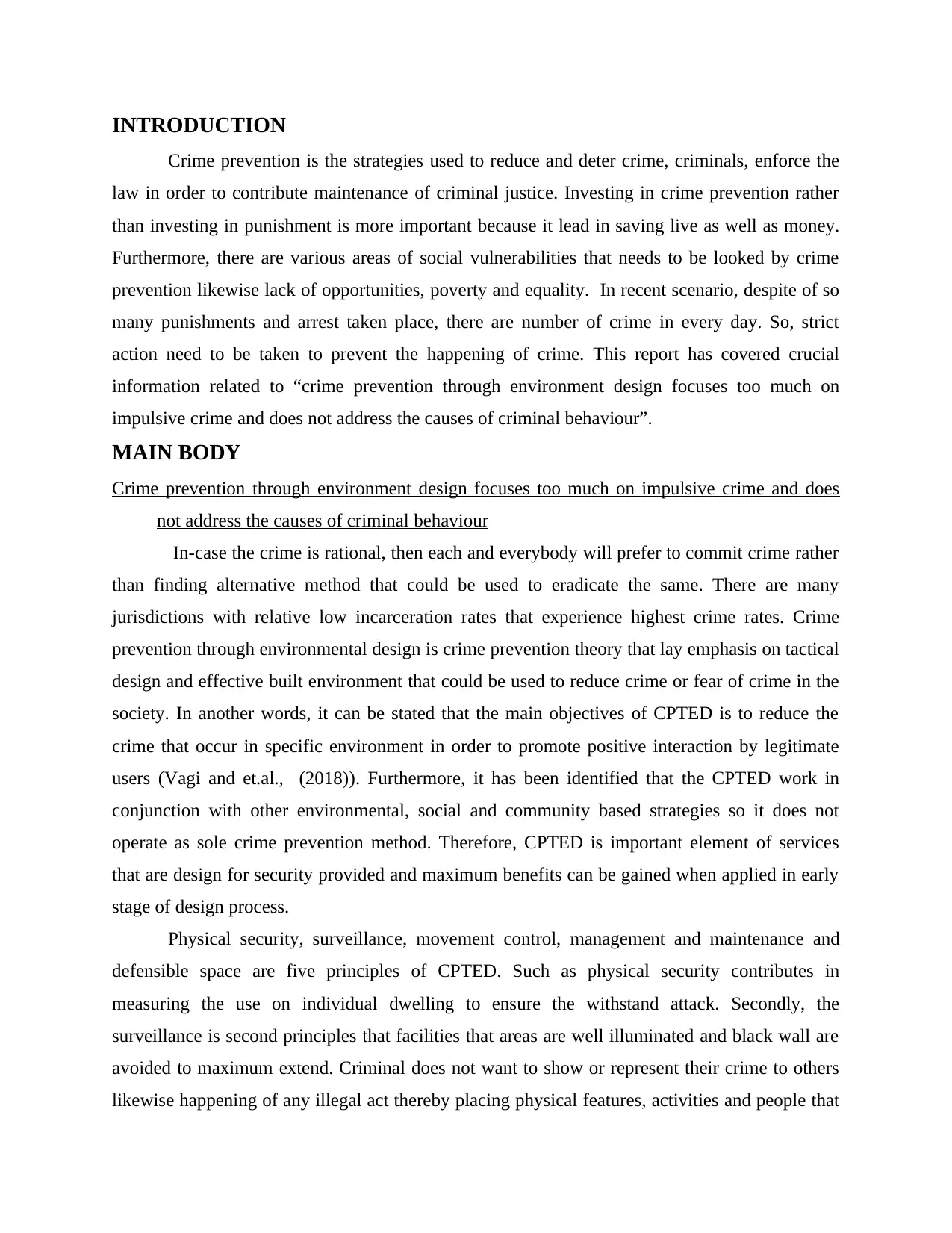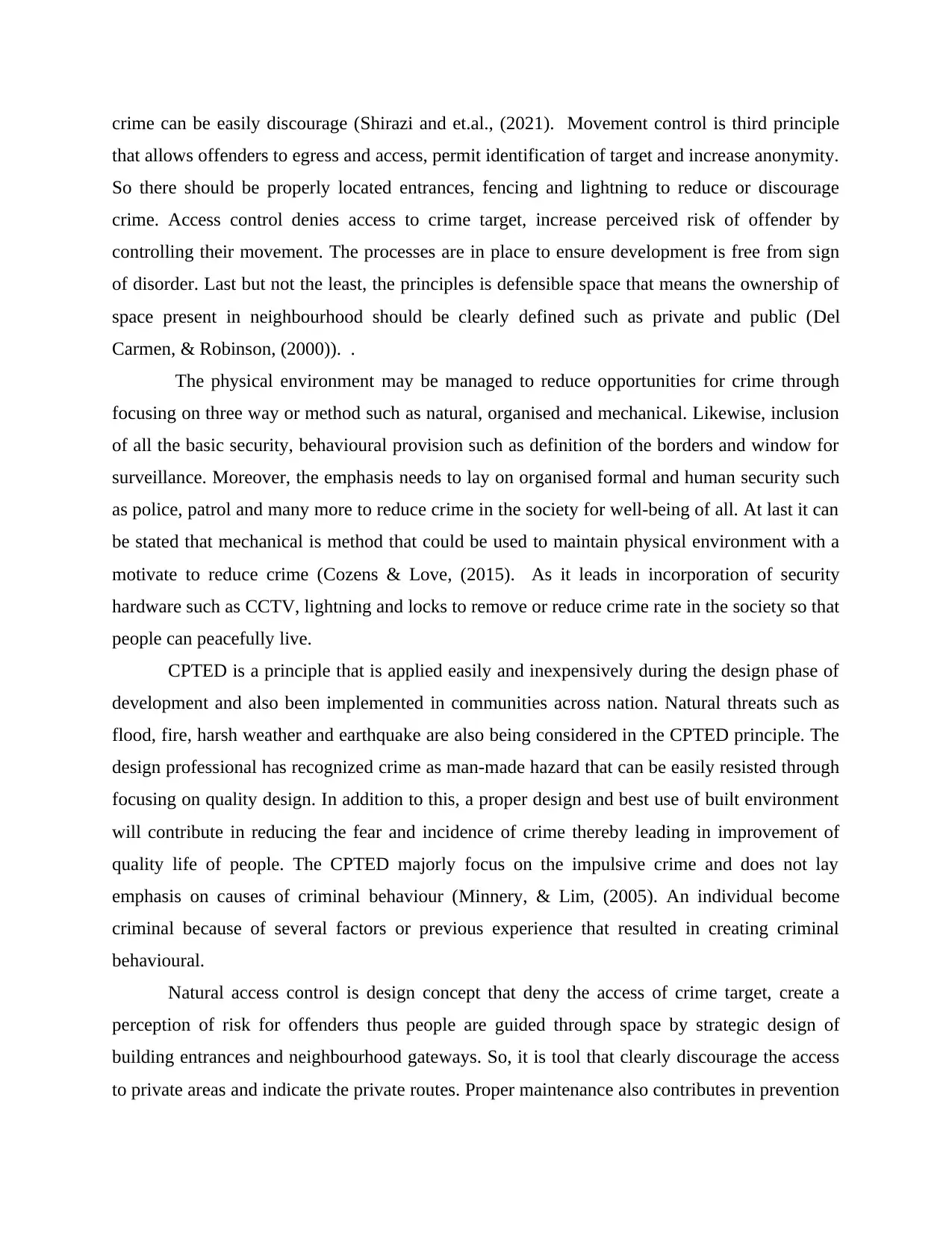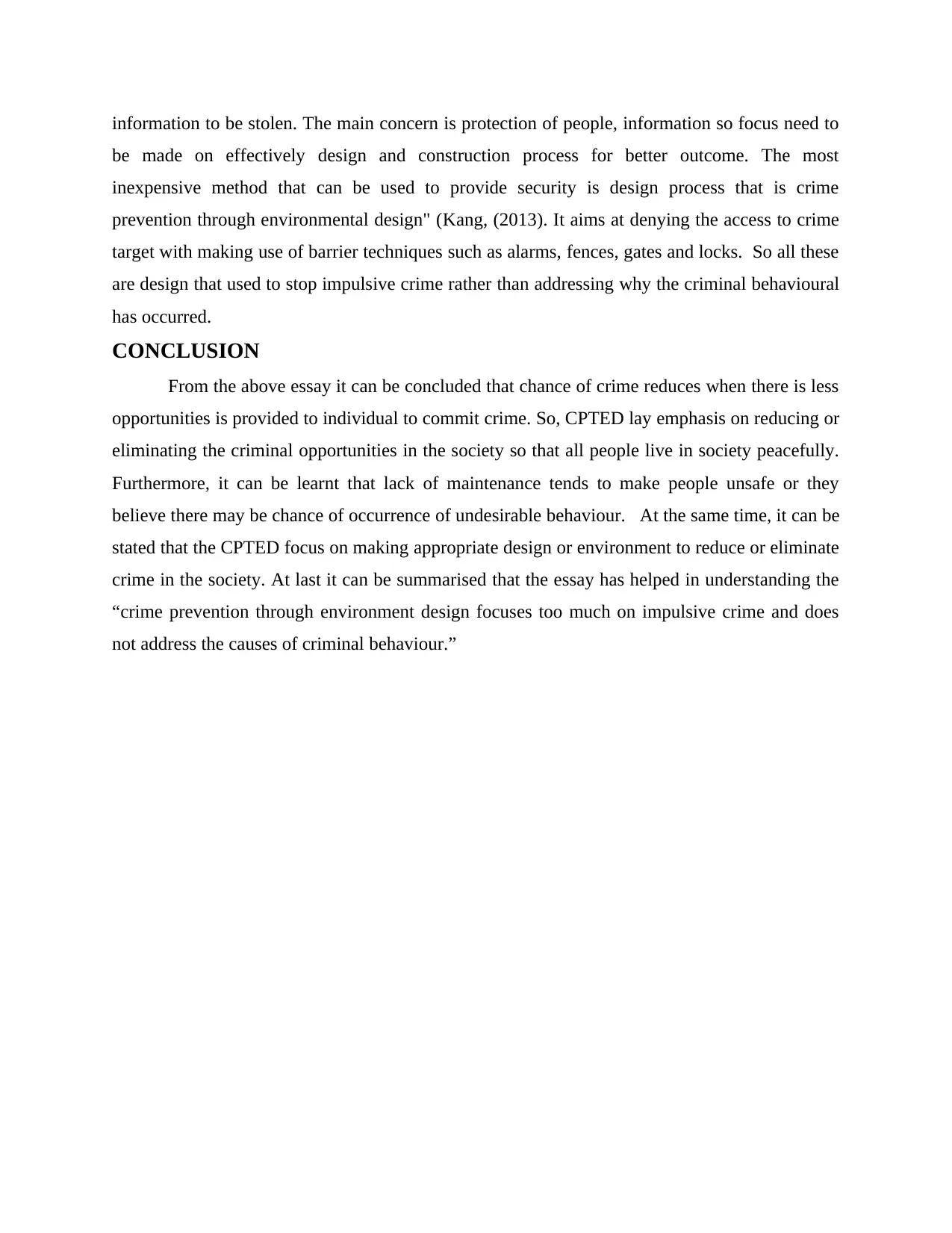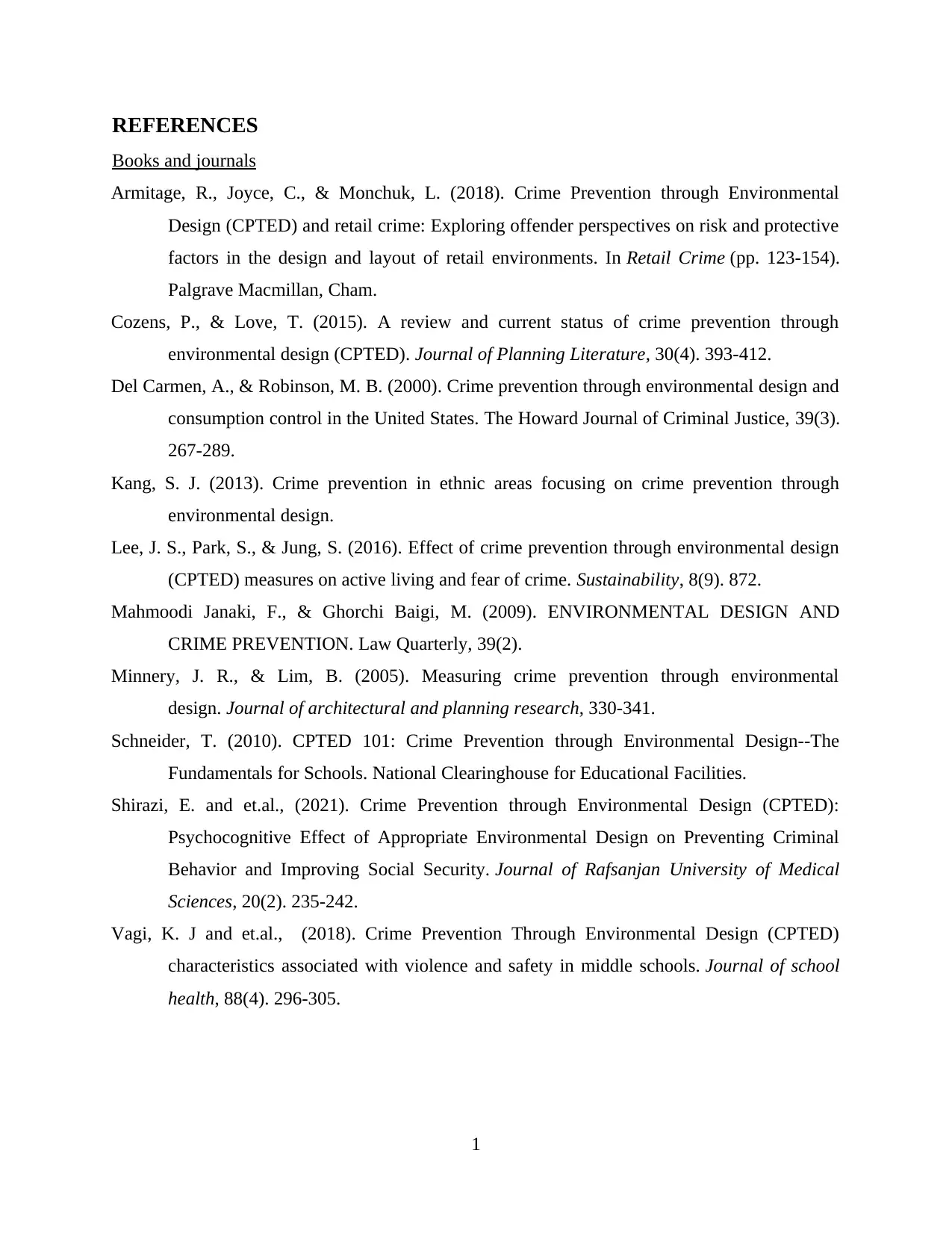Analysis of Crime Prevention Through Environmental Design (CPTED)
VerifiedAdded on 2023/06/18
|8
|2102
|97
Essay
AI Summary
This essay critically examines crime prevention through environmental design (CPTED), focusing on its primary emphasis on reducing impulsive crime by altering physical environments. It argues that while CPTED strategies, such as enhancing physical security, surveillance, and access control, can effectively deter opportunistic offenses, they often fail to address the underlying causes of criminal behavior, including poverty, low self-esteem, family conditions, and past experiences. The essay explores the core principles of CPTED, including natural access control and defensible space, and evaluates their effectiveness in reducing victimization and building a sense of community. It concludes that while CPTED is a valuable tool for crime prevention, a more comprehensive approach is needed to address the root causes of crime and promote long-term social well-being. Desklib offers a range of resources, including past papers and solved assignments, to support students studying criminology and related fields.

WRITTEN RESPONSE
Paraphrase This Document
Need a fresh take? Get an instant paraphrase of this document with our AI Paraphraser

TABLE OF CONTENTS
INTRODUCTION...........................................................................................................................3
MAIN BODY...................................................................................................................................3
Crime prevention through environment design focuses too much on impulsive crime and does
not address the causes of criminal behaviour..............................................................................3
CONCLUSION................................................................................................................................6
REFERENCES................................................................................................................................1
INTRODUCTION...........................................................................................................................3
MAIN BODY...................................................................................................................................3
Crime prevention through environment design focuses too much on impulsive crime and does
not address the causes of criminal behaviour..............................................................................3
CONCLUSION................................................................................................................................6
REFERENCES................................................................................................................................1

INTRODUCTION
Crime prevention is the strategies used to reduce and deter crime, criminals, enforce the
law in order to contribute maintenance of criminal justice. Investing in crime prevention rather
than investing in punishment is more important because it lead in saving live as well as money.
Furthermore, there are various areas of social vulnerabilities that needs to be looked by crime
prevention likewise lack of opportunities, poverty and equality. In recent scenario, despite of so
many punishments and arrest taken place, there are number of crime in every day. So, strict
action need to be taken to prevent the happening of crime. This report has covered crucial
information related to “crime prevention through environment design focuses too much on
impulsive crime and does not address the causes of criminal behaviour”.
MAIN BODY
Crime prevention through environment design focuses too much on impulsive crime and does
not address the causes of criminal behaviour
In-case the crime is rational, then each and everybody will prefer to commit crime rather
than finding alternative method that could be used to eradicate the same. There are many
jurisdictions with relative low incarceration rates that experience highest crime rates. Crime
prevention through environmental design is crime prevention theory that lay emphasis on tactical
design and effective built environment that could be used to reduce crime or fear of crime in the
society. In another words, it can be stated that the main objectives of CPTED is to reduce the
crime that occur in specific environment in order to promote positive interaction by legitimate
users (Vagi and et.al., (2018)). Furthermore, it has been identified that the CPTED work in
conjunction with other environmental, social and community based strategies so it does not
operate as sole crime prevention method. Therefore, CPTED is important element of services
that are design for security provided and maximum benefits can be gained when applied in early
stage of design process.
Physical security, surveillance, movement control, management and maintenance and
defensible space are five principles of CPTED. Such as physical security contributes in
measuring the use on individual dwelling to ensure the withstand attack. Secondly, the
surveillance is second principles that facilities that areas are well illuminated and black wall are
avoided to maximum extend. Criminal does not want to show or represent their crime to others
likewise happening of any illegal act thereby placing physical features, activities and people that
Crime prevention is the strategies used to reduce and deter crime, criminals, enforce the
law in order to contribute maintenance of criminal justice. Investing in crime prevention rather
than investing in punishment is more important because it lead in saving live as well as money.
Furthermore, there are various areas of social vulnerabilities that needs to be looked by crime
prevention likewise lack of opportunities, poverty and equality. In recent scenario, despite of so
many punishments and arrest taken place, there are number of crime in every day. So, strict
action need to be taken to prevent the happening of crime. This report has covered crucial
information related to “crime prevention through environment design focuses too much on
impulsive crime and does not address the causes of criminal behaviour”.
MAIN BODY
Crime prevention through environment design focuses too much on impulsive crime and does
not address the causes of criminal behaviour
In-case the crime is rational, then each and everybody will prefer to commit crime rather
than finding alternative method that could be used to eradicate the same. There are many
jurisdictions with relative low incarceration rates that experience highest crime rates. Crime
prevention through environmental design is crime prevention theory that lay emphasis on tactical
design and effective built environment that could be used to reduce crime or fear of crime in the
society. In another words, it can be stated that the main objectives of CPTED is to reduce the
crime that occur in specific environment in order to promote positive interaction by legitimate
users (Vagi and et.al., (2018)). Furthermore, it has been identified that the CPTED work in
conjunction with other environmental, social and community based strategies so it does not
operate as sole crime prevention method. Therefore, CPTED is important element of services
that are design for security provided and maximum benefits can be gained when applied in early
stage of design process.
Physical security, surveillance, movement control, management and maintenance and
defensible space are five principles of CPTED. Such as physical security contributes in
measuring the use on individual dwelling to ensure the withstand attack. Secondly, the
surveillance is second principles that facilities that areas are well illuminated and black wall are
avoided to maximum extend. Criminal does not want to show or represent their crime to others
likewise happening of any illegal act thereby placing physical features, activities and people that
⊘ This is a preview!⊘
Do you want full access?
Subscribe today to unlock all pages.

Trusted by 1+ million students worldwide

crime can be easily discourage (Shirazi and et.al., (2021). Movement control is third principle
that allows offenders to egress and access, permit identification of target and increase anonymity.
So there should be properly located entrances, fencing and lightning to reduce or discourage
crime. Access control denies access to crime target, increase perceived risk of offender by
controlling their movement. The processes are in place to ensure development is free from sign
of disorder. Last but not the least, the principles is defensible space that means the ownership of
space present in neighbourhood should be clearly defined such as private and public (Del
Carmen, & Robinson, (2000)). .
The physical environment may be managed to reduce opportunities for crime through
focusing on three way or method such as natural, organised and mechanical. Likewise, inclusion
of all the basic security, behavioural provision such as definition of the borders and window for
surveillance. Moreover, the emphasis needs to lay on organised formal and human security such
as police, patrol and many more to reduce crime in the society for well-being of all. At last it can
be stated that mechanical is method that could be used to maintain physical environment with a
motivate to reduce crime (Cozens & Love, (2015). As it leads in incorporation of security
hardware such as CCTV, lightning and locks to remove or reduce crime rate in the society so that
people can peacefully live.
CPTED is a principle that is applied easily and inexpensively during the design phase of
development and also been implemented in communities across nation. Natural threats such as
flood, fire, harsh weather and earthquake are also being considered in the CPTED principle. The
design professional has recognized crime as man-made hazard that can be easily resisted through
focusing on quality design. In addition to this, a proper design and best use of built environment
will contribute in reducing the fear and incidence of crime thereby leading in improvement of
quality life of people. The CPTED majorly focus on the impulsive crime and does not lay
emphasis on causes of criminal behaviour (Minnery, & Lim, (2005). An individual become
criminal because of several factors or previous experience that resulted in creating criminal
behavioural.
Natural access control is design concept that deny the access of crime target, create a
perception of risk for offenders thus people are guided through space by strategic design of
building entrances and neighbourhood gateways. So, it is tool that clearly discourage the access
to private areas and indicate the private routes. Proper maintenance also contributes in prevention
that allows offenders to egress and access, permit identification of target and increase anonymity.
So there should be properly located entrances, fencing and lightning to reduce or discourage
crime. Access control denies access to crime target, increase perceived risk of offender by
controlling their movement. The processes are in place to ensure development is free from sign
of disorder. Last but not the least, the principles is defensible space that means the ownership of
space present in neighbourhood should be clearly defined such as private and public (Del
Carmen, & Robinson, (2000)). .
The physical environment may be managed to reduce opportunities for crime through
focusing on three way or method such as natural, organised and mechanical. Likewise, inclusion
of all the basic security, behavioural provision such as definition of the borders and window for
surveillance. Moreover, the emphasis needs to lay on organised formal and human security such
as police, patrol and many more to reduce crime in the society for well-being of all. At last it can
be stated that mechanical is method that could be used to maintain physical environment with a
motivate to reduce crime (Cozens & Love, (2015). As it leads in incorporation of security
hardware such as CCTV, lightning and locks to remove or reduce crime rate in the society so that
people can peacefully live.
CPTED is a principle that is applied easily and inexpensively during the design phase of
development and also been implemented in communities across nation. Natural threats such as
flood, fire, harsh weather and earthquake are also being considered in the CPTED principle. The
design professional has recognized crime as man-made hazard that can be easily resisted through
focusing on quality design. In addition to this, a proper design and best use of built environment
will contribute in reducing the fear and incidence of crime thereby leading in improvement of
quality life of people. The CPTED majorly focus on the impulsive crime and does not lay
emphasis on causes of criminal behaviour (Minnery, & Lim, (2005). An individual become
criminal because of several factors or previous experience that resulted in creating criminal
behavioural.
Natural access control is design concept that deny the access of crime target, create a
perception of risk for offenders thus people are guided through space by strategic design of
building entrances and neighbourhood gateways. So, it is tool that clearly discourage the access
to private areas and indicate the private routes. Proper maintenance also contributes in prevention
Paraphrase This Document
Need a fresh take? Get an instant paraphrase of this document with our AI Paraphraser

of plant overgrowth, lighting and additional expression of ownership. Crime prevention through
environment design focus on impulsive crime i.,e violent crime that arise suddenly under
pressure of intense emotional affective involvement rather than the cause of criminal behaviour.
As it focus entirely on design building or environment where the people can live at safe and
secure place for their health and safety (Lee, Park & Jung, (2016)). So, the CPTED does not
focus on finding what all factors or circumstances that influence individual to become a criminal.
Furthermore, impulsive is tendency to act without thinking so this kind of behaviour is
somewhat uncommon and sign of trouble. The principles of CPTED helps in dealing with the
impulsive but no emphasis has been made on addressing the issue or causes of criminal
behavioural. Along with it, there are different cause of criminal behaviour such as low self-
esteem, poverty and alcohol as such individual are motivated to break the law (Mahmoodi
Janaki, & Ghorchi Baigi, (2009). Family condition, past experience and situations or
circumstances are also various factors that motivate a person to become a criminal. So the
approaches that is used to deterring the criminal behavioural is laying focus on place they are
laid out, how they look and feel. In another words, it suggests the way place can be changed or
altering the design with a goal to reduce fear, crime and improve quality of life. The strategies of
CPTED contribute in reducing the victimisation, deter offender decision and build a sense of
community so that they can gain territorial control of reduce crime in the areas (Armitage, Joyce
& Monchuk, (2018)).
Single family home is one of the technique of CPTED in which residential areas are heart
of the community or place at which they feel safe and secure. So, the principle related to it is
“knowing thy neighbour” likewise the stress as well as homes need to be design in effectively
manner so that people can easily interact with each other and build relationship. Neighbourhood,
Multi-Family Homes-Single Buildings and Complexes, Institutions Commercial Drive-Through
are some more techniques that could be used in context of CPTED as that helps in reducing the
chance of crime (Schneider, (2010). But no much efforts have been laid in this approach to
understand the reason related to why a criminal behavioural has been made in the person. So,
that corrective action can be made to teach the individual about what is right and what is wrong
or eliminate the chance of crime for benefits of all.
Therefore, at last it can be said that crime prevention is systematic integration of
technology, design and operation in order to protect three aspects such as people, poverty and
environment design focus on impulsive crime i.,e violent crime that arise suddenly under
pressure of intense emotional affective involvement rather than the cause of criminal behaviour.
As it focus entirely on design building or environment where the people can live at safe and
secure place for their health and safety (Lee, Park & Jung, (2016)). So, the CPTED does not
focus on finding what all factors or circumstances that influence individual to become a criminal.
Furthermore, impulsive is tendency to act without thinking so this kind of behaviour is
somewhat uncommon and sign of trouble. The principles of CPTED helps in dealing with the
impulsive but no emphasis has been made on addressing the issue or causes of criminal
behavioural. Along with it, there are different cause of criminal behaviour such as low self-
esteem, poverty and alcohol as such individual are motivated to break the law (Mahmoodi
Janaki, & Ghorchi Baigi, (2009). Family condition, past experience and situations or
circumstances are also various factors that motivate a person to become a criminal. So the
approaches that is used to deterring the criminal behavioural is laying focus on place they are
laid out, how they look and feel. In another words, it suggests the way place can be changed or
altering the design with a goal to reduce fear, crime and improve quality of life. The strategies of
CPTED contribute in reducing the victimisation, deter offender decision and build a sense of
community so that they can gain territorial control of reduce crime in the areas (Armitage, Joyce
& Monchuk, (2018)).
Single family home is one of the technique of CPTED in which residential areas are heart
of the community or place at which they feel safe and secure. So, the principle related to it is
“knowing thy neighbour” likewise the stress as well as homes need to be design in effectively
manner so that people can easily interact with each other and build relationship. Neighbourhood,
Multi-Family Homes-Single Buildings and Complexes, Institutions Commercial Drive-Through
are some more techniques that could be used in context of CPTED as that helps in reducing the
chance of crime (Schneider, (2010). But no much efforts have been laid in this approach to
understand the reason related to why a criminal behavioural has been made in the person. So,
that corrective action can be made to teach the individual about what is right and what is wrong
or eliminate the chance of crime for benefits of all.
Therefore, at last it can be said that crime prevention is systematic integration of
technology, design and operation in order to protect three aspects such as people, poverty and

information to be stolen. The main concern is protection of people, information so focus need to
be made on effectively design and construction process for better outcome. The most
inexpensive method that can be used to provide security is design process that is crime
prevention through environmental design" (Kang, (2013). It aims at denying the access to crime
target with making use of barrier techniques such as alarms, fences, gates and locks. So all these
are design that used to stop impulsive crime rather than addressing why the criminal behavioural
has occurred.
CONCLUSION
From the above essay it can be concluded that chance of crime reduces when there is less
opportunities is provided to individual to commit crime. So, CPTED lay emphasis on reducing or
eliminating the criminal opportunities in the society so that all people live in society peacefully.
Furthermore, it can be learnt that lack of maintenance tends to make people unsafe or they
believe there may be chance of occurrence of undesirable behaviour. At the same time, it can be
stated that the CPTED focus on making appropriate design or environment to reduce or eliminate
crime in the society. At last it can be summarised that the essay has helped in understanding the
“crime prevention through environment design focuses too much on impulsive crime and does
not address the causes of criminal behaviour.”
be made on effectively design and construction process for better outcome. The most
inexpensive method that can be used to provide security is design process that is crime
prevention through environmental design" (Kang, (2013). It aims at denying the access to crime
target with making use of barrier techniques such as alarms, fences, gates and locks. So all these
are design that used to stop impulsive crime rather than addressing why the criminal behavioural
has occurred.
CONCLUSION
From the above essay it can be concluded that chance of crime reduces when there is less
opportunities is provided to individual to commit crime. So, CPTED lay emphasis on reducing or
eliminating the criminal opportunities in the society so that all people live in society peacefully.
Furthermore, it can be learnt that lack of maintenance tends to make people unsafe or they
believe there may be chance of occurrence of undesirable behaviour. At the same time, it can be
stated that the CPTED focus on making appropriate design or environment to reduce or eliminate
crime in the society. At last it can be summarised that the essay has helped in understanding the
“crime prevention through environment design focuses too much on impulsive crime and does
not address the causes of criminal behaviour.”
⊘ This is a preview!⊘
Do you want full access?
Subscribe today to unlock all pages.

Trusted by 1+ million students worldwide

REFERENCES
Books and journals
Armitage, R., Joyce, C., & Monchuk, L. (2018). Crime Prevention through Environmental
Design (CPTED) and retail crime: Exploring offender perspectives on risk and protective
factors in the design and layout of retail environments. In Retail Crime (pp. 123-154).
Palgrave Macmillan, Cham.
Cozens, P., & Love, T. (2015). A review and current status of crime prevention through
environmental design (CPTED). Journal of Planning Literature, 30(4). 393-412.
Del Carmen, A., & Robinson, M. B. (2000). Crime prevention through environmental design and
consumption control in the United States. The Howard Journal of Criminal Justice, 39(3).
267-289.
Kang, S. J. (2013). Crime prevention in ethnic areas focusing on crime prevention through
environmental design.
Lee, J. S., Park, S., & Jung, S. (2016). Effect of crime prevention through environmental design
(CPTED) measures on active living and fear of crime. Sustainability, 8(9). 872.
Mahmoodi Janaki, F., & Ghorchi Baigi, M. (2009). ENVIRONMENTAL DESIGN AND
CRIME PREVENTION. Law Quarterly, 39(2).
Minnery, J. R., & Lim, B. (2005). Measuring crime prevention through environmental
design. Journal of architectural and planning research, 330-341.
Schneider, T. (2010). CPTED 101: Crime Prevention through Environmental Design--The
Fundamentals for Schools. National Clearinghouse for Educational Facilities.
Shirazi, E. and et.al., (2021). Crime Prevention through Environmental Design (CPTED):
Psychocognitive Effect of Appropriate Environmental Design on Preventing Criminal
Behavior and Improving Social Security. Journal of Rafsanjan University of Medical
Sciences, 20(2). 235-242.
Vagi, K. J and et.al., (2018). Crime Prevention Through Environmental Design (CPTED)
characteristics associated with violence and safety in middle schools. Journal of school
health, 88(4). 296-305.
1
Books and journals
Armitage, R., Joyce, C., & Monchuk, L. (2018). Crime Prevention through Environmental
Design (CPTED) and retail crime: Exploring offender perspectives on risk and protective
factors in the design and layout of retail environments. In Retail Crime (pp. 123-154).
Palgrave Macmillan, Cham.
Cozens, P., & Love, T. (2015). A review and current status of crime prevention through
environmental design (CPTED). Journal of Planning Literature, 30(4). 393-412.
Del Carmen, A., & Robinson, M. B. (2000). Crime prevention through environmental design and
consumption control in the United States. The Howard Journal of Criminal Justice, 39(3).
267-289.
Kang, S. J. (2013). Crime prevention in ethnic areas focusing on crime prevention through
environmental design.
Lee, J. S., Park, S., & Jung, S. (2016). Effect of crime prevention through environmental design
(CPTED) measures on active living and fear of crime. Sustainability, 8(9). 872.
Mahmoodi Janaki, F., & Ghorchi Baigi, M. (2009). ENVIRONMENTAL DESIGN AND
CRIME PREVENTION. Law Quarterly, 39(2).
Minnery, J. R., & Lim, B. (2005). Measuring crime prevention through environmental
design. Journal of architectural and planning research, 330-341.
Schneider, T. (2010). CPTED 101: Crime Prevention through Environmental Design--The
Fundamentals for Schools. National Clearinghouse for Educational Facilities.
Shirazi, E. and et.al., (2021). Crime Prevention through Environmental Design (CPTED):
Psychocognitive Effect of Appropriate Environmental Design on Preventing Criminal
Behavior and Improving Social Security. Journal of Rafsanjan University of Medical
Sciences, 20(2). 235-242.
Vagi, K. J and et.al., (2018). Crime Prevention Through Environmental Design (CPTED)
characteristics associated with violence and safety in middle schools. Journal of school
health, 88(4). 296-305.
1
Paraphrase This Document
Need a fresh take? Get an instant paraphrase of this document with our AI Paraphraser

2
1 out of 8
Related Documents
Your All-in-One AI-Powered Toolkit for Academic Success.
+13062052269
info@desklib.com
Available 24*7 on WhatsApp / Email
![[object Object]](/_next/static/media/star-bottom.7253800d.svg)
Unlock your academic potential
Copyright © 2020–2025 A2Z Services. All Rights Reserved. Developed and managed by ZUCOL.





